Nestled in the lush cloud forests of the Andes, a small but dazzling creature flits from flower to flower, its emerald feathers gleaming in the dappled sunlight. This is the Andean emerald hummingbird, a true gem of South America’s avian world. With its striking appearance and crucial role in its ecosystem, this tiny bird captures the imagination of birdwatchers and scientists alike. In this article, we’ll explore the fascinating world of the Andean emerald hummingbird, delving into its habitat, unique characteristics, and the challenges it faces in our changing world.
Habitat and Distribution
Where Does the Andean Emerald Hummingbird Live?

The Andean emerald hummingbird, scientifically known as Uranomitra franciae, makes its home in the breathtaking Andes mountains. This species thrives in the cloud forests and subtropical regions of Colombia, Ecuador, and northern Peru. Specifically, these agile flyers prefer elevations between 800 and 2,500 meters above sea level, with most populations concentrated above 1,000 meters.
These hummingbirds have adapted to life in various forest types. They frequent the edges and clearings of wet primary forests, where lush vegetation provides ample nectar sources. Additionally, they’ve shown remarkable adaptability by colonizing secondary forests, which are areas of regrowth after human disturbance. In Peru, the Andean emerald has even been observed in drier shrublands, demonstrating its versatility in habitat selection.
The distribution of the Andean emerald hummingbird spans across three distinct subspecies:
-
U. f. franciae inhabits the northwestern and central Andes of Colombia.
-
The U. f. viridiceps ranges from southwestern Colombia’s Nariño Department through western Ecuador to Loja Province.
-
And the U. f. cyanocollis is found in southeastern Ecuador’s Zamora-Chinchipe Province and extends into northern Peru’s Marañón River valley, reaching as far as La Libertad Province.
Environmental Challenges
Despite their adaptability, Andean emerald hummingbirds face significant environmental challenges. Deforestation poses a major threat to their habitat. As human populations expand and agriculture encroaches on forest lands, these birds lose crucial nesting sites and food sources. Moreover, climate change is altering the delicate balance of their mountain ecosystems.
Conservation efforts in the Andes region are crucial for protecting the cloud forests these hummingbirds call home. Many organizations work tirelessly to establish protected areas and promote sustainable land use practices. These initiatives not only benefit the Andean emerald but also countless other species that depend on these unique habitats.
Physical Characteristics and Behavior
Andean Emerald (Amazilia franciae) in Mindo, Ecuador.
What Makes Them Unique?
The Andean emerald hummingbird is a marvel of nature’s design. Measuring just 9 to 11 centimeters in length, these diminutive birds pack a lot of beauty into their small frames. Males typically weigh around 5.6 grams, while females are slightly lighter at about 5.3 grams.
Their most striking feature is undoubtedly their plumage. The nominate subspecies, U. f. franciae, boasts a glittering violet-blue crown that catches the light beautifully. Their cheeks and neck shimmer with golden to emerald green feathers, creating a dazzling contrast. The upperparts and flanks display a light green to golden-green coloration, often with a coppery tinge on the uppertail coverts.
One of the most remarkable adaptations of the Andean emerald, like all hummingbirds, is its ability to hover. Their wings can beat up to 80 times per second, allowing them to remain stationary in mid-air as they feed on nectar. This unique flight capability enables them to access food sources that other birds simply cannot reach.
Interestingly, there are subtle differences between males and females. While both sexes share many features, females typically have a turquoise-blue to greenish crown that is less glittering than that of males. Juveniles resemble adult females but often have brownish edges on their upperpart feathers and grayish-brown flanks.
Feeding Habits
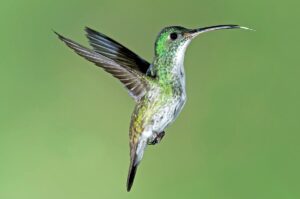
Nectar forms the primary diet of the Andean emerald hummingbird. These birds have co-evolved with many flowering plants in their habitat,
developing long, specialized bills perfectly suited for reaching deep into tubular flowers. Their preference for certain flowers, such as Heliconia, highlights the intricate relationships between plants and pollinators in the Andean ecosystem.
While nectar provides the bulk of their energy needs, Andean emeralds also supplement their diet with small insects. This protein-rich food source is particularly important during breeding seasons when energy demands are high. The hummingbirds often catch insects through a method called hawking, where they dart out from a perch to snatch flying insects mid-air.
The feeding behavior of Andean emeralds is a sight to behold. They often employ a strategy known as trap-lining, where they visit a circuit of nectar sources in a repeating pattern. This method allows them to efficiently gather nectar while giving flowers time to replenish between visits.
Role in Ecosystem
Pollination Partners
The ecological importance of the Andean emerald hummingbird cannot be overstated. As they flit from flower to flower in search of nectar, these tiny birds play a crucial role in pollination. Their long bills and ability to hover make them ideal pollinators for many plant species that have evolved alongside them.
Many plants in the Andean cloud forests have developed specialized relationships with hummingbirds like the Andean emerald. These plants often have tubular flowers that are perfectly shaped to accommodate the hummingbird’s bill. As the bird feeds, pollen sticks to its feathers and is then transferred to the next flower it visits, facilitating plant reproduction.
This symbiotic relationship benefits both the hummingbirds and the plants. The birds receive a reliable source of energy-rich nectar, while the plants ensure their genetic material is spread to other individuals of their species. This intricate dance of co-evolution has been taking place for millions of years, shaping the biodiversity of the Andean region.
Threats to Biodiversity
The decline of species like the Andean emerald hummingbird could have far-reaching consequences for the ecosystems they inhabit. As pollinators, these birds help maintain the genetic diversity of plant populations. If their numbers were to decrease significantly, it could lead to reduced plant reproduction and, ultimately, changes in forest composition.
Furthermore, the Andean emerald’s role in the food web extends beyond its relationship with plants. As both predator (of small insects) and prey (for larger birds and some mammals), these hummingbirds are an integral part of the energy flow in their ecosystem. Their loss could potentially disrupt this delicate balance.
Local communities and global conservation initiatives play a vital role in protecting the Andean emerald and its habitat. By promoting sustainable land use practices and supporting protected areas, these efforts help ensure the continued survival of this species and the many others that depend on the same ecosystem.
Cultural Significance
Symbolism in Andean Culture
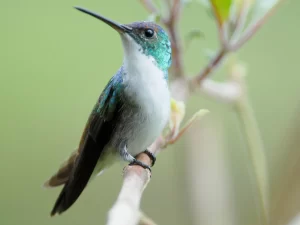
The Andean emerald hummingbird, like many of its relatives, holds a special place in the hearts and minds of people living in the Andes. These vibrant birds have long been symbols of beauty, resilience, and the interconnectedness of all living things in Andean folklore and traditions.
In many indigenous cultures of the region, hummingbirds are seen as messengers between the earthly realm and the spirit world. Their ability to hover and fly backwards is often interpreted as a symbol of the ability to reflect on the past while moving forward. The Andean emerald’s dazzling plumage has inspired countless works of art, from intricate textiles to colorful pottery.
Local legends often feature hummingbirds as characters embodying qualities such as perseverance and adaptability. These stories not only entertain but also serve to pass down important cultural values and ecological knowledge from generation to generation.
Ecotourism Opportunities
The allure of the Andean emerald hummingbird extends far beyond the local communities, attracting nature enthusiasts from around the world. Birdwatching has become an increasingly popular activity in the Andes region, with the Andean emerald being a prized sighting for many visitors.
This growing interest in ecotourism presents both opportunities and challenges for local communities. On one hand, it provides a sustainable source of income that incentivizes forest conservation. Many lodges and guided tours now cater specifically to birdwatchers, creating jobs and economic opportunities in rural areas.
However, it’s crucial that this tourism is managed responsibly. Overzealous birdwatchers can potentially disturb nesting sites or disrupt feeding patterns. Many tour operators now focus on educating visitors about responsible wildlife viewing practices, ensuring that the pursuit of seeing these beautiful birds doesn’t come at the cost of their well-being.
When done right, ecotourism centered around species like the Andean emerald can be a powerful tool for conservation. It raises awareness about the importance of preserving cloud forest habitats and provides tangible economic benefits to local communities who act as stewards of these ecosystems.
Frequently Asked Questions
How Long Do Andean Emerald Hummingbirds Live?
Andean emerald hummingbirds typically live for 4 to 5 years in the wild. However, some individuals may live longer under optimal conditions. Factors such as habitat quality, food availability, and predation pressure can all influence their lifespan.
How Can I Help Protect Them?
There are several ways to contribute to the conservation of Andean emerald hummingbirds:
-
Support conservation organizations working in the Andes region.
-
Reduce your carbon footprint to help mitigate climate change impacts on their habitat.
-
If you visit their habitat, practice responsible ecotourism.
-
Spread awareness about the importance of cloud forest conservation.
-
Consider planting native, nectar-producing plants if you live in their range.
Are They Endangered?
Currently, the Andean emerald hummingbird is not classified as endangered. The International Union for Conservation of Nature (IUCN) lists it as a species of Least Concern. However, this doesn’t mean they face no threats. Habitat loss remains a significant concern, and continued monitoring is essential to ensure their populations remain stable.
While not currently endangered, the Andean emerald’s status could change if the pressures on its habitat intensify. Conservation efforts are crucial to maintain healthy populations and prevent this species from becoming threatened in the future.
Conclusion
The Andean emerald hummingbird stands as a testament to the incredible diversity and beauty of life in the Andes mountains. From its dazzling plumage to its crucial role in pollination, this tiny bird embodies the intricate connections that exist within cloud forest ecosystems.
As we’ve explored, the Andean emerald faces challenges from habitat loss and climate change. Yet, it also represents hope. Through conservation efforts, responsible ecotourism, and increased awareness, we have the opportunity to ensure that future generations can marvel at the sight of these jewel-like birds flitting through the misty forests of the Andes.
The story of the Andean emerald hummingbird is more than just a tale of a beautiful bird. It’s a reminder of the delicate balance that exists in nature and the role we play in maintaining it. By protecting species like the Andean emerald, we’re not just saving a bird – we’re preserving entire ecosystems and the cultural heritage they inspire.
As you reflect on the wonders of the Andean emerald hummingbird, consider how you might contribute to its conservation. Whether through supporting local initiatives, practicing responsible tourism, or simply sharing what you’ve learned, every action counts. Together, we can help ensure that the emerald jewels of the Andes continue to sparkle in the cloud forests for generations to come.
Hummingbird Resources
Here’s a complete guide to attracting hummingbirds to your yard. It lists plants, vines and shrubs that are in bloom for spring, summer and fall. Your hummingbirds will always have flowers to feed on.
Here’s a great article that tells everything you need to know about how to choose the best place to hang your hummingbird feeder.
Here’s the best designed hummingbird feeder to use. It’s leak proof, so it won’t attract insects and it’s easy to take apart and clean.
Here’s a comprehensive guide to help you clean your hummingbird feeder for those times when the nectar is not changed soon enough and mold starts to grow.
One of the best Hummingbird feeders that’s easy to take apart and clean is the HummZinger Ultra.
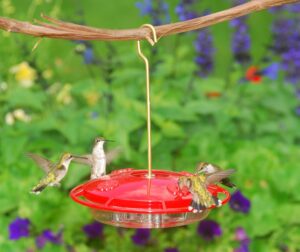
Aspects 12oz HummZinger Ultra With Nectar Guard.
The HummZinger Ultra 12oz Saucer Feeder is one of the best options for a hummingbird feeder that’s both easy to clean and maintain. This top-tier feeder features patented Nectar Guard tips—flexible membranes on the feeding ports that keep flying insects out while still allowing hummingbirds to feed freely. Plus, it comes with an integrated ant moat to prevent crawling insects from reaching the nectar, and the raised flower ports help divert rain, keeping the nectar fresh.
With a 12 oz capacity, this mid-size feeder offers plenty of space and can be hung or mounted on a post using the included hardware. It has four feeding ports and is made from durable, unbreakable polycarbonate. Whether you’re concerned about bees, wasps, or ants, this feeder is built for easy cleaning and insect protection.
If you already have a hummingbird feeder, and you want to protect it from ants and other crawling insects, the ant moat below will do the job.
Trap-It Ant Moat for Hummingbird Feeders
Using an ant moat for your hummingbird feeder is an effective way to keep ants away from the sweet nectar. These tiny creatures are drawn to
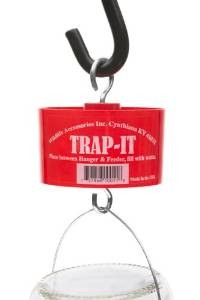
the sugar water, and without a barrier, they will quickly infest your feeder, preventing the birds from enjoying the nectar. An ant moat works by creating a barrier of water that ants can’t cross. Positioned above the feeder, it effectively blocks the ants’ path, keeping them from reaching the nectar.
This simple solution also ensures that your hummingbird feeder remains clean and accessible for the birds, rather than becoming a breeding ground for ants or other pests. It’s a small addition that can make a big difference in maintaining a healthy, inviting space for hummingbirds, while also reducing the need for chemical ant deterrents.
The first and still the best to protect your Hummingbird and Oriole feeder from ants and other crawling insects. Insert between hanger and feeder and fill with water, providing a barrier to crawling pests. Red color to attract hummingbirds.
| Small bottle brushes and pipe cleaners are always helpful to dislodge mold inside the feeder and in the feeding ports. It is necessary to have a clean mold free feeder to attract hummingbirds and to keep them healthy. |
Window feeder for a close up viewing area
Experience the thrill of watching hummingbirds up close as they hover right outside your window. With a hummingbird window feeder!
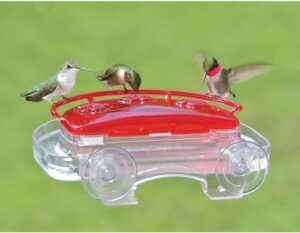
Having a hummingbird window feeder brings the excitement of nature right to your window. Imagine watching these vibrant, tiny birds hover just inches away as they sip nectar. Their iridescent feathers glisten in the light, and their rapid wing beats create a mesmerizing display you can enjoy from the comfort of your home. It’s a truly unique and personal experience, offering a front-row seat to nature’s most agile acrobats.
What makes a hummingbird window feeder even more thrilling is how often these fascinating creatures visit. You’ll get to see them return throughout the day, sometimes making multiple stops at your feeder. Each visit is a new opportunity to observe their graceful movements and learn more about these incredible birds. It’s like having your own live wildlife show right outside your window!
Beyond the joy of bird watching, a hummingbird window feeder adds a burst of color and life to your space. Whether you’re relaxing indoors or enjoying a cup of coffee, the sight of these dazzling creatures brings a touch of serenity and beauty to your day. It’s a simple, yet unforgettable way to connect with nature without leaving home.
If you found this article helpful please share it with your friends using the social bookmarking buttons on the left side of this page. Help everyone to increase their enjoyment of feeding hummingbirds. Do it for the hummingbirds!
Hummingbird Resources
U.S. Fish and Wildlife Service – Hummingbird Conservation
This site offers detailed information about various hummingbird species, their habitats, and conservation efforts. It also provides resources on how to protect these fascinating birds.
National Park Service – Hummingbird Resources
The National Park Service offers insights into hummingbird species found in national parks, their behaviors, and their role in ecosystems, along with tips for observing them.
Smithsonian National Museum of Natural History – Birds: Hummingbirds
This resource provides educational materials on the role of hummingbirds in pollination and biodiversity, backed by scientific research and exhibits from the Smithsonian.
U.S. Geological Survey – Hummingbird Studies
The USGS offers research on hummingbird migration patterns, population dynamics, and environmental threats, including studies on climate change impacts.


